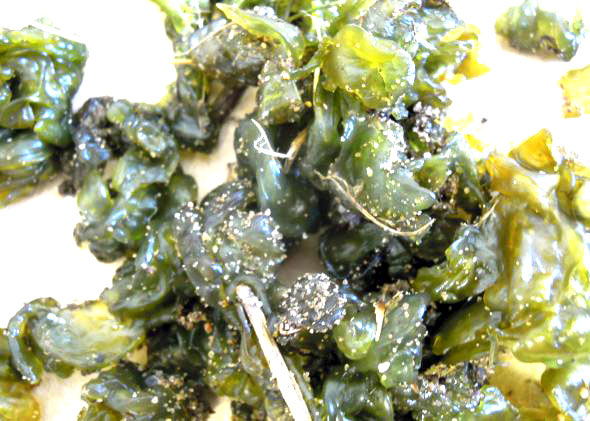Q&A – Ask Neil: May 15, 2025
(Please read these instructions carefully.)
Before you post your question, please look at recent issues to see if someone else has already asked it. You might find your answer there.
How to submit your question…
(Note: You may need to allow a pop-up window to come up in order to get the link for sending your photo(s). If you have already submitted your question and didn’t see the pop-up window, please click here.)
• Click the link provided below to post your question. After you submit your question, a new window will pop up giving you the address to which you can e-mail a SHARP, HIGH-RESOLUTION PHOTO to accompany your question. Please DO NOT SEND THUMBNAIL PHOTOS in case I need to zoom in to see things.
• Click here to post your question.
• Please ONLY POST YOUR QUESTION ONE TIME. We can only accept a set number of questions each week, and when we get duplicates it costs other people their chances.
• One question per reader, please.
• Please use this only for posting questions – not for standard emails.
• Watch for your answer in the following week’s e-gardens.
• I choose those of greatest general interest. For example, plant IDs seldom make the cut.
• I must have your first name or initials.
• I must have your city or county. (Texas is a very large state.)
QUESTION 1
WHY DO MY CELEBRITY TOMATOES NOT SET FRUIT?
Question: For the second year in a row my Celebrity tomatoes aren’t setting fruit. I planted 4 in the same garden I have used for 13 years. The plants are huge and healthy, but every single blossom falls off. I have tried shaking them. I have fed and watered them regularly. The cherry tomatoes nearby are producing just fine. Zinnias as well, so I believe there’s enough sunlight. What else can I do? Mary Lynn J., Fair Oaks Ranch, Bexar County.
Answer: I made my mental list of things that might be wrong, and you checked them off one by one. Let me fine-tune a few. You need to thump the flower clusters with your finger tip, not shake the plants. Think as if you were thumping a small paper wad across a tabletop. Thump each flower cluster every other morning. You might be marginal on the amount of sunlight the Celebrities are getting. Try them in another location next spring (or even planted mid-summer for a fall garden). It’s possible that you have root knot nematodes in their soil, although those microscopic soil-borne pests normally will cause the plants to be stunted as well. My best advice would be to plant four different varieties next time, for example, Celebrity, Better Boy, Super Fantastic, and Early Girl. Admittedly, Celebrity is probably the best variety among them, but having more than one type would give you a better read on the situation.
QUESTION 2
I JUST PLANTED PALMETTO ST. AUGUSTINE. WHEN SHOULD I USE “NEW LAWN STARTER?”
Question: I planted Palmetto St. Augustine sod this week. When should I use Scott’s New Lawn Starter? My soil test came back low in nitrogen, phosphorus, and potash. It has a pH of 7.5-8.5. I applied Bonus S weed-and-feed in early March. Randa M., Austin.
Answer: Apply the new lawn product after you mow the lawn the second time. That may already have happened. It will have a very high content of phosphorus (middle number of the analysis). That element accumulates in clay soils such as much of Austin has, so be forewarned that you can rapidly accumulate an excess of phosphorus, to the detriment of other minor elements. You’ll probably want to switch over to an all-nitrogen food after this first feeding. As warm as it’s getting, that may not be until early September. The grass came with nutrients in its root zone, so it should be fine. Your weed-and-feed product had a herbicide that may persist a while in the soil. You don’t want to use pre-emergents when you intend to plant new sod or seed the same season. I’d suggest you get a Texas Certified Nursery Professional involved in guiding your decisions as you choose your products. That’s going to take you into an independent retail garden center where you’ll be able to talk to a full-time horticultural expert.
QUESTION 3
WHY DO THE BUDS ON MY BLACKEYED SUSANS WILT AND TURN BROWN SUDDENLY?
Question: I have several beds of blackeyed Susans. Every year they look beautiful with lots of buds, and then suddenly the tops of the flowers just wilt and turn brown. What would cause that? Denise B., Tarrant County.
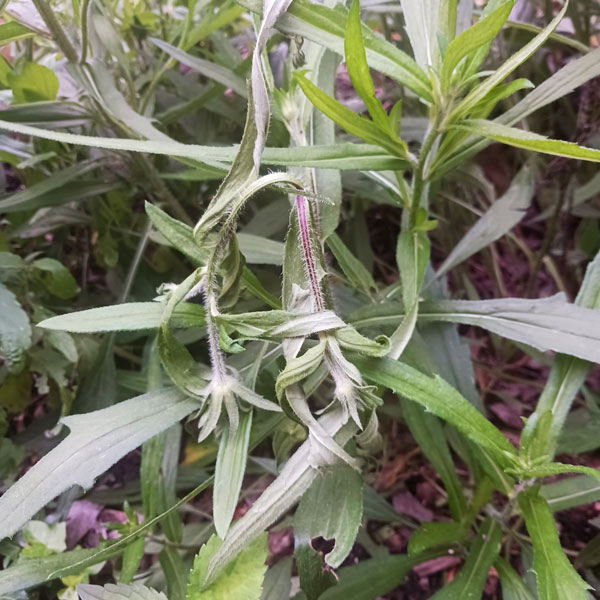
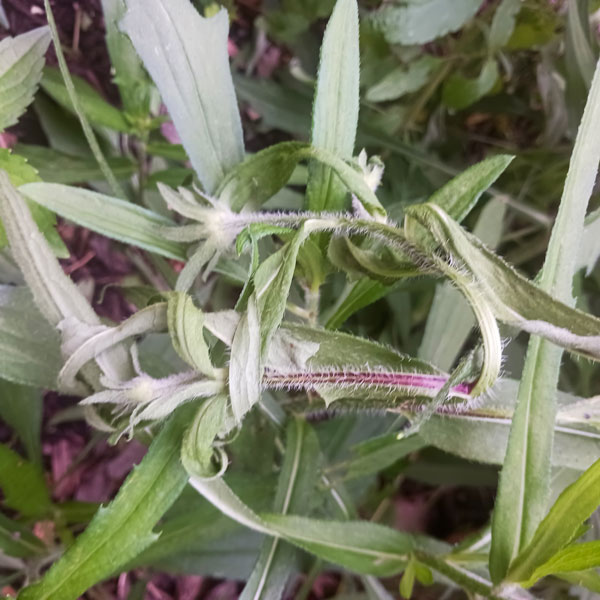

Answer: I looked carefully at all your photos. It appears to me that there has been drift of a broadleafed weedkiller, either from turf being sprayed somewhere nearby or from a weed-and-feed product washing into the bed. It can even be from residue left in a spray tank or drift from a neighbor’s yard some distance away with all the wind we’ve had this spring. I see no signs of insect damage (except to some of the older leaf margins). I would suggest cutting one of the distorted stems loose so that you can slice and examine it with a very sharp knife or a single-edged razor blade. See if you can find any evidence of an insect pest within the stem. Unless you find a significant clue in that examination, I’m out of ideas.
QUESTION 4
SHOULD I BE STAKING MY TREE?
Question: I asked you about this tree in Nov. 2023. Look at how much it has grown. But it appears to be leaning. Do I need to stake it? And how soon should I start removing lower branches? Daniel H., Brady, McCulloch County.
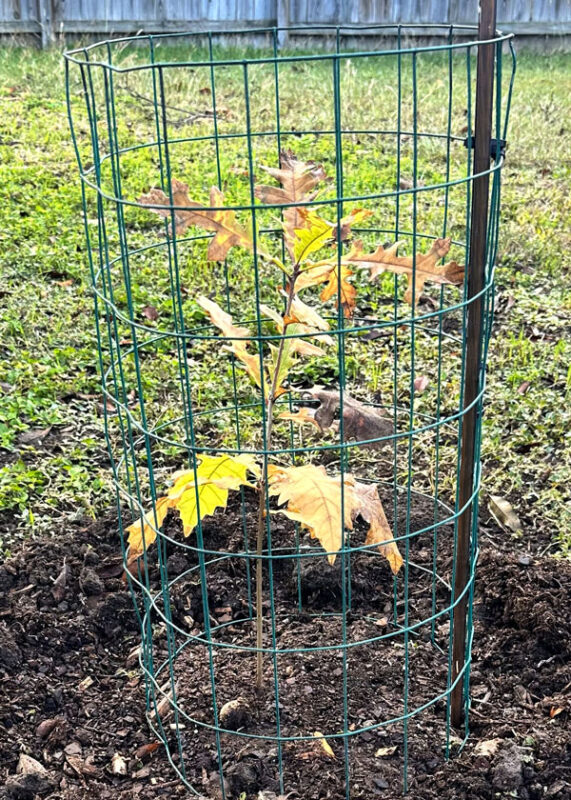
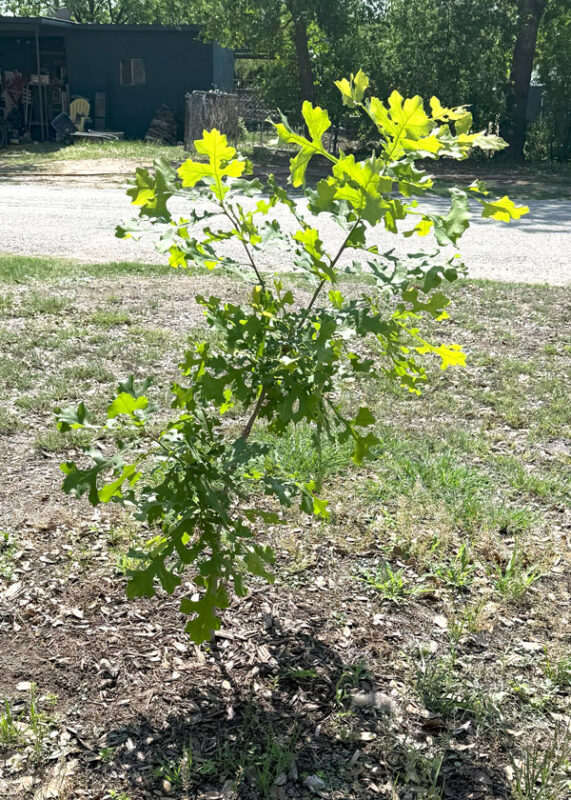
Answer: You have a bur oak, Quercus macrocarpa. Great tree. Yes on the staking. I would use a heavy pipe or 2×2-inch post driven 14 inches into the ground. Use plastic plant tie (no wire). The stake should go on the upper/left side of the trunk and right up against it. You want to focus on the stem growing up toward the upper right side of your photo. I would leave the branch coming off the left side of the trunk for the rest of this growing season, although I would pinch its growing tip out so that it doesn’t grow any larger/taller. Leaving lower branches in place but headed back will help the trunk thicken up more quickly. You would then prune and remove the lower branches a couple of years down the road.
QUESTION 5
WILL BARE SPOTS IN NELLIE R. STEVENS HOLLIES EVENTUALLY FILL IN?
Question: I would like to transplant 6-foot Nellie R. Stevens hollies from my front foundation to the back property line for privacy. They currently are against the house, so their backs and sides are bare. Will those bare spots eventually fill in if they’re planted in full sun? Gena H., Carrollton.
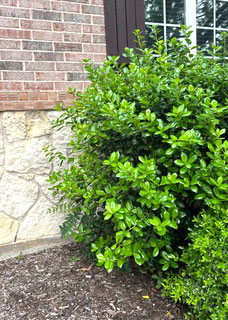
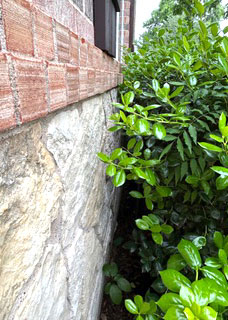
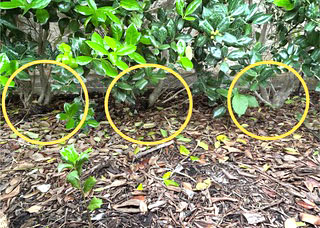
Answer: Yes. That transplanting must be done during the winter while they’re dormant, and you’ll need to move them with a firm ball of soil intact around their roots. Since they’re so large you’ll want to prune them significantly as you move them to compensate for the root loss, and that’s where you’ll help the bare spots catch up. You’ll be removing much of the foliage from the plants as you move them. Set them at the same depth at which they’re growing now and apply a root stimulator plant food to help them get re-established. Keep them moist at all times next year and they should take right off. Hopefully their root systems haven’t become too firmly established and trunks grown too large. This will be a significant amount of work.
QUESTION 6
HOW LONG BEFORE OKLAHOMA REDBUD SEEDLINGS START TO BLOOM?
Question: I have a few seedlings from my neighbor’s Oklahoma redbud. I’d like to plant them in another part of my yard. What are my chances of success? How long before they are mature enough to start blooming? Wanda B., Garland.
Answer: Redbud seedlings generally start to flower after 5 to 7 years. I don’t know of any reason why seedlings from an Oklahoma redbud would be any different. However, hopefully you do know that the variety Oklahoma is a grafted selection, so it won’t “come true” from seed. You’ll have a redbud, and at least its mother’s genes will have the deep rich wine color.
QUESTION 7
HOW CAN I SAVE MY LAWN?
Question: How can I save my lawn? I’m tired of fighting weeds while the bermuda seems unable to take over the bare spots and weed territory. The whole area is just weeds with some tiny specks of bermuda and St. Augustine. Olga G-O, Dallas, Collin County.
Answer: Your first step must be to determine why the grass hasn’t been growing up until now. A minimum of 6 hours of direct, hot summer sun daily is required. Lack of sun is the cause of symptoms like you described 95 percent of the time. Poor watering techniques and insect or disease problems would make up the other 5 percent. I know we’ve addressed this from several different angles before here. I do want to help, but without a photo that’s the best I can suggest. It wouldn’t cost that much to buy a few yards of bermuda sod and plant it as a test. If there’s enough sunlight you will be able to tell within 6 or 8 weeks. If the shade is excessive it will obviously begin to thin and die out.
QUESTION 8
HOW CAN I COPE WITH NOSTOC IN MY LAWN?
Question: I have that slimy green stuff that I believe is called Nostoc. How do I address it in my lawn? Randall, DeSoto.
Answer: Randall called my KLIF radio program this past Saturday. I told him I was familiar with Nostoc, but that it had been many years since anyone had asked about it. I said I’d like to have a bit of time to do the research on how best to cope with it in lawns and landscapes. Following is a summation of what I found.
Nostoc is an extremely primitive jelly-like substance dating back 3.5 billion years. It’s a cyanobacterium that survives all types of environmental conditions.
It’s usually best to use a shovel and to wear disposable plastic gloves as you scoop and remove it. Send it to the landfill. Keep pets away from it.
University reports on Nostoc…
Here are detailed fact sheets on this organism for anyone wanting to read up on all the information.
Michigan State
https://www.canr.msu.edu/news/nostoc_a_green_jelly_like_substance_growing_in_lawns
Clemson
https://hgic.clemson.edu/factsheet/nostoc/
University of Georgia
https://extension.uga.edu/story.html?storyid=7998&story=Nostoc-Algae
Purdue University
https://www.purduelandscapereport.org/article/lawn-jelly-star-jelly-nostoc-by-any-other-name-is-just-as-slimy/
University of Florida
http://blogs.ifas.ufl.edu/nassauco/2016/01/10/what-is-this-scary-looking-slime-in-my-lawn/
Ohio State University
https://bygl.osu.edu/node/1258


